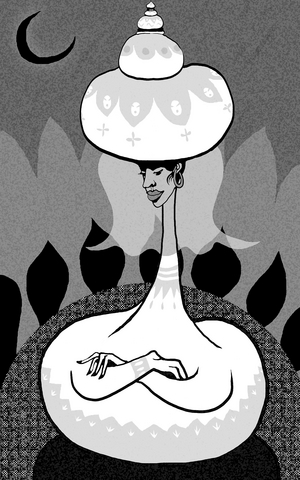At a tiny courtyard mosque tucked down a back alley in China's Muslim heartland, Wang Shouying leads other Muslim women in prayers and chants.
Every day, Wang dons a green velvet robe and white scarf and preaches to dozens of women at the Little White Mosque in western China's Ningxia region.
Wang is a keeper of a centuries-old tradition that gives women a leading role in a largely male-dominated faith. She is a female imam, or ahong, from the Persian word akhund for "the learned."

"We need to train and educate our female comrades how to be good Muslims," Wang said between prayer sessions. "Women ahong are the best qualified to do this because they can relate to the female faithful in ways the male ahong can't."
Religion was banned during Mao Zedong's (毛澤東) radical Cultural Revolution but faith made a comeback in the 1980s, increasing the numbers of Buddhists, Taoists, Muslims and Christians. The communist push for gender equality helped broaden Muslim women's roles.
China's women imams are not the equals of male prayer leaders. They do not lead salat -- the five daily prayers considered among the most important Muslim obligations. Those prayers are instead piped via loudspeakers into the female mosques from the male ones nearby.
Still, the female imams guide others in worship and are the primary spiritual leaders for the women in their communities.
Although it's not unusual in Islam for women to lead other women in prayer, China's female imams are part of a trend of greater leadership roles for Muslim women in many nations, said Omid Safi, professor of Islamic studies at the University of North Carolina-Chapel Hill.
Chinese Muslims are carrying on a tradition that fell away in many Muslim societies after national governments centralized religious institutions, making men the leaders, said Ingrid Mattson, an Islamic scholar at Hartford Seminary in Connecticut.
"This tradition has roots," said Wang, whose mosque's whitewashed brick outer wall bears the characters n?si (女寺) -- "women's mosque" -- in pink. "I don't know what they call us in other places or how it's done elsewhere but we respect the Koran here."
Women's equal status in work and religion is evident across Ningxia, a swathe of desert traversed by the Yellow River which was settled by Muslim traders from the Middle East a millennium ago.
Women here work beside men in government offices, banks, shops and schools. Religious schools for girls are common. Often women maintain separate mosques, virtually identical to those led by men.
"The Chinese Communist Party liberated us from the kitchen and it gave us the same duties and obligations as men," said Wu Yulian, a 45-year-old Muslim mother of two and principal at the Yisha Hui People's Kindergarten in Wuzhong.
"I believe that men and women are equal by nature and that the practice of restricting women in some parts of the Middle East, like not allowing them outside, not allowing them to drive or be seen by men is really unfair and excessive," she said.
Closer ties to the rest of the Muslim world are behind the growing interest in Islamic and Arabic studies.
China's trade with the Arab world grew tenfold over the last decade, hitting US$51.3 billion last year. And relaxed passport controls have made it easier for China's estimated 20 million Muslims to make the hajj pilgrimage to Saudi Arabia, with nearly 10,000 expected to go this year, compared with just seven Chinese pilgrims in 1978.
In Ningxia, where individual rural incomes hover around US$315 per year, more young Muslim women see learning Arabic as a way out of poverty.
"It gives them a chance for employment," said Ma Mingxian, vice principal of the Institute for the Study of Islam and the Koran in the regional capital of Yinchuan. "She can be a translator, a teacher, or she can go on to study Islam at a higher level."
Ma's institute started accepting female students in 1992. Now 118 girls are enrolled and Ma is turning away applicants for lack of space.
At Wuzhong's imposing Central Mosque, 32-year-old Yan Mingnan shares duties with her imam husband -- he to the men, she to the women.
Yan said he is paid more -- about US$75 a month compared to her US$40 -- but he does more in the mosque while she cares for their two children.
"His burden is greater than mine because he has more students and leads the salat," Yan said.
Down a dusty track on the outskirts of Wuzhong, 30 girls study at the Muslim Village Girls' School for Arabic Studies -- a private boarding school set up by a local businessman.
Inside the converted courtyard farmhouse, they sing: "We are all Muslim youth, we have a holy mission and bear the hope of humankind."
Inside the school's office, an illegal satellite hookup broadcasts programs from Yemen, Syria, Saudi Arabia and Southeast Asia.
But drawing closer to worldwide Islam may come at a price in Ningxia, where a new generation of women may start to question whether their tradition of female imams is truly Islamic.
At Ma's institute, 18-year-old Zhao Hongmei, in a long black robe and pink scarf fastened tight under her chin, shakes her head when asked if she would consider becoming an imam.
"Women aren't allowed to be ahong," said the sophomore from Ningxia's Haiyuan County, where there are dozens of mosques and female imams. "Some might call them that, say so and so is an ahong, but really they are female scholars."
As for the many Muslim women on the streets of Yinchuan who choose not to the wear the hijab, or headscarf, Zhao said: "It's because they haven't been taught the real Islam."

Donald Trump’s return to the White House has offered Taiwan a paradoxical mix of reassurance and risk. Trump’s visceral hostility toward China could reinforce deterrence in the Taiwan Strait. Yet his disdain for alliances and penchant for transactional bargaining threaten to erode what Taiwan needs most: a reliable US commitment. Taiwan’s security depends less on US power than on US reliability, but Trump is undermining the latter. Deterrence without credibility is a hollow shield. Trump’s China policy in his second term has oscillated wildly between confrontation and conciliation. One day, he threatens Beijing with “massive” tariffs and calls China America’s “greatest geopolitical
Chinese Nationalist Party (KMT) Chairwoman Cheng Li-wun (鄭麗文) made the astonishing assertion during an interview with Germany’s Deutsche Welle, published on Friday last week, that Russian President Vladimir Putin is not a dictator. She also essentially absolved Putin of blame for initiating the war in Ukraine. Commentators have since listed the reasons that Cheng’s assertion was not only absurd, but bordered on dangerous. Her claim is certainly absurd to the extent that there is no need to discuss the substance of it: It would be far more useful to assess what drove her to make the point and stick so
The central bank has launched a redesign of the New Taiwan dollar banknotes, prompting questions from Chinese Nationalist Party (KMT) legislators — “Are we not promoting digital payments? Why spend NT$5 billion on a redesign?” Many assume that cash will disappear in the digital age, but they forget that it represents the ultimate trust in the system. Banknotes do not become obsolete, they do not crash, they cannot be frozen and they leave no record of transactions. They remain the cleanest means of exchange in a free society. In a fully digitized world, every purchase, donation and action leaves behind data.
The Honduran elections seem to have put China on defense. The promises of trade and aid have failed to materialize, industries are frustrated, and leading candidate Salvador Nasralla, who has increased his lead in the polls, has caused Beijing to engage in a surge of activity that appears more like damage control than partnership building. As Nasralla’s momentum has grown, China’s diplomacy, which seems to be dormant since the establishment of diplomatic relations in 2023, has shown several attempts to avoid a reversal if the Liberal or the National party — which also favor Taipei — emerge as winners in the